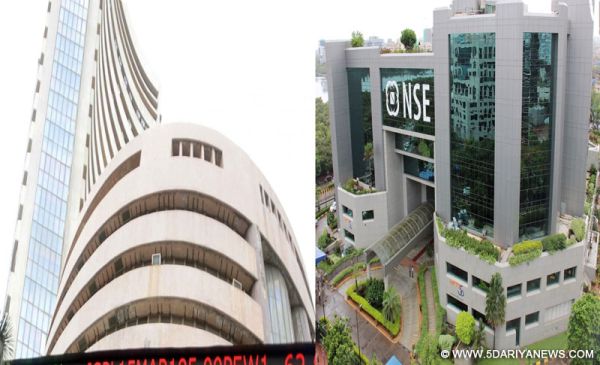
by admin | May 25, 2021 | Banking, Economy, Finance, Markets, News
 Mumbai : Healthy buying in banking, FMCG and consumer durable stocks lifted the key Indian equity indices on Monday with the BSE Sensex setting a fresh benchmark of 36,749.69 points by the fag end of the day’s trade.
Mumbai : Healthy buying in banking, FMCG and consumer durable stocks lifted the key Indian equity indices on Monday with the BSE Sensex setting a fresh benchmark of 36,749.69 points by the fag end of the day’s trade.
Investor sentiments were boosted after Goods and Services Tax on many items including electronic appliances were slashed on Saturday, analysts said.
Index-wise, the BSE Sensex closed at 36,718.60 points — higher by 222.23 points and 0.61 per cent — from the previous close of 36,496.37 points.
The wider Nifty50 on the National Stock Exchange closed the day’s trade at 11,084.75 points, up 74.55 points or 0.68 per cent from the previous close of 11,010.20 points.
As mentioned, the Sensex touched an all-time high of 36,749.69 points, and an intra-day low of 36,491.83 points. The previous record high on Sensex was 36,747.87 hit on July 18.
In the broader markets, the S&P BSE mid-cap closed 1.29 per cent higher while the S&P BSE small-cap rose by 0.93 per cent from its previous close. The BSE market breadth was bullish with 1,511 advances against 1,089 declines.
“The gains came on the back of the government’s announcement on reduction in goods and services tax (GST) rate on 88 goods and services over the weekend,” said Deepak Jasani, Head, Retail Research, HDFC Securities.
Further, according to Abhijeet Dey, Senior Fund Manager for Equities at BNP Paribas Mutual Fund, stock market in India started the week on an upbeat note as sentiments were boosted by the government winning the no-confidence motion in the Lok Sabha on Friday, July 20.
On the currency front, the rupee closed at 68.86, depreciating by just one paisa from the previous close of 68.85 per dollar.
Investment-wise, provisional data with exchanges showed that foreign institutional investors bought scrip worth Rs 259.37 crore and the domestic institutional investors purchased stocks worth Rs 124.82.
Sector-wise, the S&P BSE banking index gained the most, by 291.31 points, followed by the consumer durables index, up 259.97 points and the FMCG rose by 259.95 points.
On the contrary, the S&P BSE energy index was the only loser with a decline of 16.54 points from its previous close.
The major gainers on the Sensex were Vedanta, up 4.42 per cent at Rs 211.55; Adani Ports, up 3.83 per cent at Rs 384.05; ITC, up 3.80 per cent at Rs 283.85; Bharti Airtel, up 3.49 per cent at Rs 357.60; and ICICI Bank, up 3.33 per cent at Rs 274.85 per share.
The top losers were Hero MotoCorp, down 6.20 per cent at Rs 3,163.90; Bajaj Auto, down 5.35 per cent at Rs 2,689.10; Wipro, down 2.47 per cent at Rs 276.05; HDFC Bank, down 1.48 per cent at Rs 2,157.75; and ONGC, down 0.86 per cent at Rs 156.50 per share.
—IANS
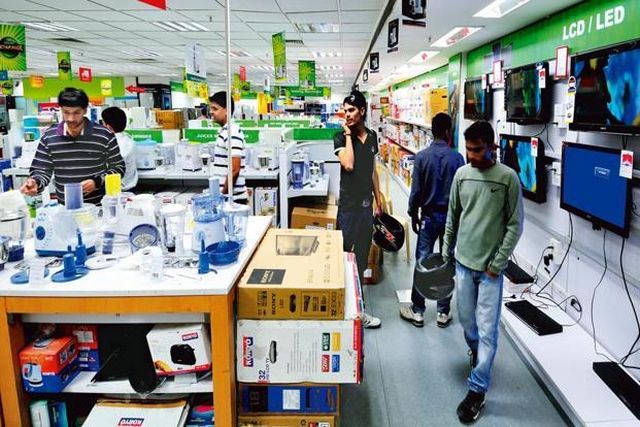
by admin | May 25, 2021 | Commodities, Commodities News, Economy, Markets, News
 New Delhi : In a relief for common man, the GST Council on Saturday reduced tax rates on over 50 items including refrigerators, washing machines and small televisions, which would now be taxed at 18 per cent, down from the current 28 per cent.
New Delhi : In a relief for common man, the GST Council on Saturday reduced tax rates on over 50 items including refrigerators, washing machines and small televisions, which would now be taxed at 18 per cent, down from the current 28 per cent.
Apart of bringing down rates, the Goods and Services Tax (GST) Council also exempted GST on sanitary napkins, rakhis, fortified milk and idols of deities made of stone, marble and wood.
The changes would come into effect across the country from July 27 onward, Finance Minister Piyush Goyal told media after the 28th meeting of the GST Council.
“Refrigerators, small televisions, of upto 25 inches, lithium ion batteries, vacuum cleaners, domestic electrical appliances, such as food grinders, mixers….storage water heaters, immersion heaters, hair dryers, hand driers, electric smoothing irons,” among others have been brought to the 18 per cent slab,” Goyal said.
The council also gave a major relief to the hotel industry by providing that tax rate shall be based on transaction value instead of declared tariff.
Earlier, there was a lack of clarity on the issue causing a lot of trouble for consumers booking hotels with ‘declared tariffs’ of Rs 7,500 and above which incurred 28 per cent GST.
While hotels with tariff below Rs 1,000 are exempted from GST, those with tariff between Rs 1,000-2,500 are taxed at 12 per cent, those between Rs 2,500-7,500 at 18 per cent, and above Rs 7,500 at 28 per cent.
However, it often happened that hotels offered discounts and hence the actual transaction cost would be much lower than the declared cost, but tax would still be charged at the declared cost.
Another significant decision the council made was regarding easing of return filing procedure by approving two new simplified forms called ‘Sugam’ and ‘Sahaj’, the minister said.
Also, enterprises with annual turnover of upto Rs 5 crore would have to file quarterly returns instead of the current monthly filing, although they would continue to pay tax on a monthly basis.
However, the implementation of the revamped return filing process would take some time as corresponding changes would have to be made into the GST network, the minister clarified.
The council also deferred the implementation of reverse charge mechanism by another year and now it will come into force from October next year.
The minister further informed that the council would have a special meeting on August 4 to address concern of small and medium enterprises.
Among other tax-reduction decisions, Goyal said, tax rate on handicraft items such as handbags, pouches and purses, jewellery box, wooden frames of paintings and photographs among others have been brought under the 12 per cent slab, from 18 per cent.
GST on handmade carpets and handmade textile floor coverings has been reduced from 12 per cent to 5 per cent.
The tax rate on ethanol, which is used in the blending of petrol and diesel also has been brought down to 5 per cent from 18 per cent.
During the meeting, the council also made certain amendments to the GST Act including raising the upper limit of turnover for opting for composition scheme from Rs 1 crore to Rs 1.5 crore.
It also approved an amendment which will enable taxpayers to opt for multiple registrations within a state in respect of multiple places of business located within the same state.
—IANS
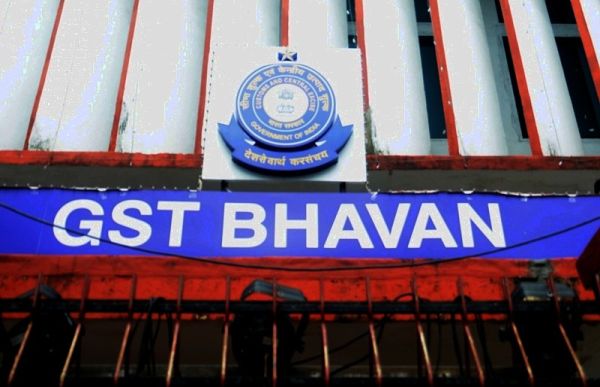
by admin | May 25, 2021 | Corporate, Corporate Governance, Economy, Finance, News, Politics
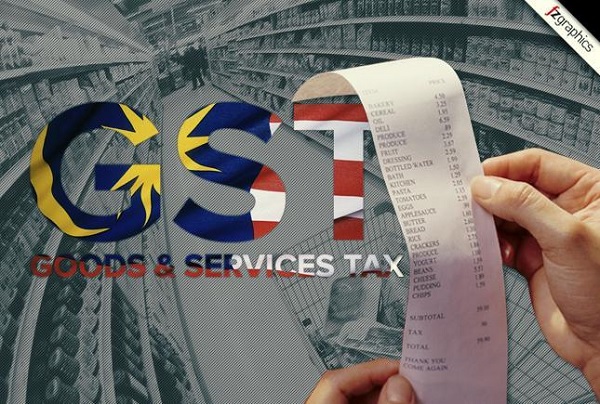 (GST completes a year on June 30)
(GST completes a year on June 30)
By Vishav,
New Delhi : Touted as the biggest economic reform since Independence, the Goods and Services Tax (GST) was supposed to replace the complex indirect tax system prevalent in the country with a more simplified, uniform regime.
As its roll-out completes one year on June 30, it can be argued that while India has come a long way from a complicated taxation system, with over a dozen different taxes and many more cesses, GST is still far away from an ideal taxation regime.
Also, the one year journey of the GST has not been a smooth one either with glitches and teething problems experienced from day one. While many of those glitches were addressed by a proactive government, some still remain to be resolved including simplification of return filing and further rationalisation of tax rates.
According to NITI Aayog Vice Chairman Rajiv Kumar: “GST has put the economy on a completely different paradigm now because more and more pressure will be on people to register under GST and bring their economic activity into the formal sector.”
It is not enough only to analyse the one year journey, but it is important to understand the future roadmap.
While many economist would argue that an ideal GST structure should have a universal coverage and a single tax rate, most would also agree that it was not practical for a country like India with vast economic disparities. This is a stand the government has also maintained often giving the example that “a BMW car and a Hawai ‘chappal’ (flip-flops) can’t be taxed at the same rate”.
However, having six different rates — 5, 12, 18 and 28 per cent apart from some items being taxed at zero per cent and gold at 3 per cent — makes India’s GST one of the most complex in the world, something acknowledged by the World Bank in its biannual India Development Update report.
“To make things worse, petroleum products, power and real estate have been kept outside the GST ambit,” the report noted.
It added that not only India has one of the largest number of tax slabs, but at 28 per cent, it has the highest standard GST rate in Asia and the second highest in the world after Chile.
Soon after the new indirect tax system was rolled out, NITI Aayog Member Bibek Debroy — who is now also the chairman of the Prime Minister’s Economic Advisory Council — had told IANS that “India is a long way off from the ideal GST structure and it may not get there anytime in the near future”.
Favouring a maximum of three GST rates with all items covered, Debroy had said that starting with seven rates, “depending on how you count it”, has put India in a situation where it may not get to the ideal GST.
Fast forward to present. The economy is still grappling with the rather high multiplicity of tax rates while also debating bringing petroleum products, electricity and other items into the GST net with little clarity in the picture.
While there has been expression of intent by the government to merge some of the tax slabs, there has been little progress on that front so far.
Right from the first day of the roll-out on July 1 last year, there were technical glitches appearing on the GST Network portal causing a lot of hardship to taxpayers in registering on the network. There were often instances of the portal not being able to take the load of last-minute rush to file returns, forcing the government to postpone the filing deadlines several times.
The glitches also led to export refunds piling up, resulting in a grave situation of cash crunch for exporters, whose working capital was getting blocked.
However, to address this, the government initiated two special fortnight-long drives (extended by a few days later) to process pending refunds — one in March and another in June — clearing a major portion of the backlog while some still remains.
To address the GST network issues, the GST Council has set up a five-member ministerial panel headed by Bihar Deputy Chief Minister Sushil Modi to oversee its functioning and smoothen the process.
“GST is a very huge and complex exercise and one has to be honest that it could be implemented better and the details could have been (better) thought through,” the NITI Aayog’s Kumar told IANS.
While there was consensus that no reform could be undertaken without some glitches and teething problems, which could be addressed as we go along, one major concern was that GST might lead to some loss of revenue, especially for the states.
This fear almost came true when GST collections fell for two consecutive months from over Rs 92,000 crore (later revised to Rs 95,132 crore) in September to Rs 83,346 crore (later revised to Rs 85,931 crore) in October, and Rs 80,808 crore (later revised to Rs 83,716 crore) in November.
This prompted the GST Council in its December meeting to prematurely roll out the e-way bill mechanism for inter-state movement of goods from February 1 to plug gaps and check tax evasion.
The e-way bill portal crashed on Day One prompting the government to extend the trial period and eventually postponing the roll-out to April 1.
According to the NITI Aayog Vice Chairman, in a country like India, which is proud of its IT sector, there is hardly any excuse for the IT systems not to work.
However, when the system was rolled out the second time on April 1, the technical issues were sorted out and infrastructure boosted enough for a smooth implementation. The revenue collections also picked up subsequently crossing the Rs 1 lakh crore mark in March (collected in April) — which was, however, attributed to the financial year-end effect — and then again showing credible buoyancy in April when it crossed the Rs 94,000 crore.
Kumar said now that the GST has stabilised, it would give a massive fillip to economic activity.
Finance Secretary Hasmukh Adhia said earlier this week that GST had now entered a “smooth phase” with good tax compliance. He added the priority of the government would now be simplification of tax return forms.
Deloitte India Partner Prashant Deshpande said while GST has resolved the issues of multiple taxable events and double taxation, there are some concerns which still need to be addressed.
“On the legislation side, GST can be improved by extending it to petroleum products, electricity, land and building which are currently taxed under old laws… The number of tiers in tax rate structure are required to be reduced to resolve classification issues,” Deshpande told IANS.
On the execution side, he added, prime concern is the GST compliance infrastructure “which is complex and cumbersome” which needs to be replaced with “a simple and robust compliance system”.
It would a while before such a system comes into effect.
Vishav can be contacted at vishav@ians.in)
(Editors: This is the first in a short series of articles leading up to one year of GST)
—IANS
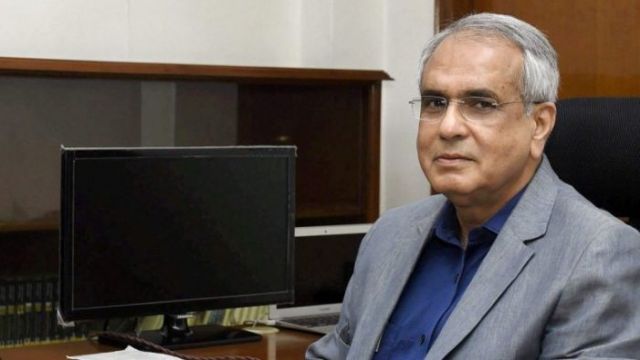
by admin | May 25, 2021 | Interviews

Vice Chairman of Niti Aayog, Rajiv Kumar
By Vishav,
New Delhi : Petroleum is the taxation milch cow for the central and the state governments and it is unlikely to be brought under the Goods and Services Tax (GST) any time soon.
That’s also the view of the Vice Chairman of Niti Aayog, Rajiv Kumar. Several senior ministers have demanded that petroleum products — basically petrol and diesel — be brought under the the new taxation regime.
But says Kumar: “It (oil) can’t be brought under GST. That’s because the total state and central taxes on petrol put together are around 90 per cent right now.”
He told IANS in an interview here: “I can’t see how any state will take a cut so huge as the highest rate under the GST is 28 per cent. A new GST band will have to be opened up — and that will be an enormous exercise.”
While supporting “in principle” the idea of bringing all items under the new indirect tax system, he said those talking about doing it now have not thought this through.
“The better way to do this is to first start reducing taxes (on petroleum products) as I have said many times in public. States impose ad-valorem tax on oil and so they all had a windfall gain (when prices rose). There is a need to rationalise it,” he said, adding “states should especially cut taxes.”
Kumar said that both the central and the state governments should start the process of weaning themselves away from their dependence on oil taxation.
According to him, the Central government collects Rs 2.5 lakh crore as tax on oil while almost Rs 2 lakh crore is collected by the states. “From where will they compensate it?” he asks adding that if the taxes are reduced gradually, the burden on the economy will get reduced.
“Higher oil prices are like a tax on the economy. If oil prices are brought down, economic activity will also improve,” Kumar said.
“Once that is achieved, once the revenues have gone up from other sources and the economy has picked up, then you can think of bringing oil under GST. It’s not that easy,” he added.
Ever since the new tax legislation was rolled out on July 1 last year, there had been talk of bringing it under the GST with top government officials and ministers supporting the need for such a move. The Opposition parties, of course, have been clamouring for it.
In December last year, Finance Minister Arun Jaitley had told the Rajya Sabha that the Central government was in favour of bringing petroleum products under the ambit of GST after building a consensus with states.
More recently, in April, when the international crude oil prices were going up sharply, pushing the domestic petrol prices to record levels, BJP President Amit Shah told a rally in Mumbai that efforts were on to bring petrol and diesel under the GST.
From Road Transport and Highways Minister Nitin Gadkari to Petroleum and Naural Gas Minister Dharmendra Pradhan, almost every senior BJP minister has favoured bringing petroleum products under the GST.
Among states, Maharashtra Chief Minister Devendra Fadnavis has also expressed willingness to bring petrol and diesel under GST in his state if a consensus was brought about on it.
Kumar says he was in favour of such a change, but it has to be thought through in practical terms.
“I am just simply saying that let’s not try to hurry it because you would only run into problems as there is a huge dependence on oil,” he said.
“Even electricity should be brought under GST. Everything should be under GST. But I am not sure whether it is worked out yet. Let’s agree to bring it under GST but over a period of time as is practical,” he said.
(Vishav can be contacted at vishav@ians.in)
—IANS
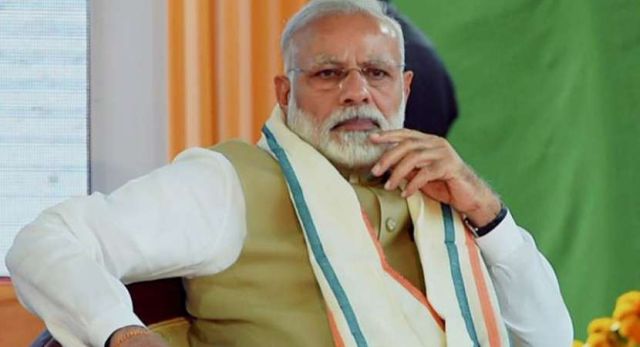
by admin | May 25, 2021 | News, Politics
 New Delhi : Prime Minister Narendra Modi on Sunday said that information technology has replaced the ‘Inspector Raj’ under the Goods and Services Tax (GST), as he termed the first year of the indirect tax regime as a “victory of integrity, celebration of honesty and a symbol of cooperative federalism”.
New Delhi : Prime Minister Narendra Modi on Sunday said that information technology has replaced the ‘Inspector Raj’ under the Goods and Services Tax (GST), as he termed the first year of the indirect tax regime as a “victory of integrity, celebration of honesty and a symbol of cooperative federalism”.
In the 45th edition of his monthly radio address ‘Mann ki Baat’, he credited states with “successful” implementation of the ‘One nation, one tax’ reform, saying people of different ideologies have taken part in its 27 meetings but its decisions have been unanimous.
In his address, Modi took a veiled dig at the opposition while referring to his “greatest satisfaction” at seeing people transform their lives through the video bridge programmes in which he interacted with beneficiaries of government schemes.
“There are certain people in society, who find no solace till they do not express their frustrated views, their depressed views and seek ways to divide rather than unite. In such an environment, when the common man comes to you talking about emerging hope, new zeal and events that have taken place in his life, it is not to the government’s credit,” he said.
Modi also credited Jana Sangh founder Syama Prasad Mookerjee with laying a strong foundation for country’s industrial development in his capacity as Independent India’s first Industry Minister.
The Prime Minister also invoked Sant Kabir and Guru Nanak to derive home the message of social harmony and brotherhood.
Pointing out that 2019 would mark the 550th Prakash Parv (birth anniversary) of Guru Nanak Dev, the founder of Sikhism, Modi urged his followers to think about ways in which this historic occasion should be celebrated.
“Guru Nanak Dev wanted to end caste discrimination in society and to embrace entire mankind as one. He used to say that to serve the poor and the needy was to serve God,” he said.
Recalling the sacrifice made by freedom fighters at Jallianwala Bagh in 1919, he said: “We must also remember the everlasting message that this incident has imparted, that is, violence and cruelty can never solve any problem. It is peace and non-violence, renunciation and martyrdom that are triumphant in the end!”
On GST, Modi said that although it was estimated that in a country as vast as India, it would take five to seven years for the “world’s biggest tax reform” to get streamlined but it has stabilised in just a year, and under it Information Technology had replaced ‘Inspector Raj’ as everything from return-to-refund was being done online with little manual interference.
Modi said he had interacted with 40-50 lakh people, including farmers and beneficiaries of government schemes through his video bridge programmes, and that it imparted him with new strength.
He said an incident regarding a small girl from a remote village too can inspire the 125 crore people.
“With the help of technology, through the video bridge even a single moment spent with the beneficiaries was very enjoyable, very motivational and provided satisfaction to work more. There is a renewed joy in dedicating your life for the upliftment, and you’re left with renewed fervour and inspiration.”
Modi greeted doctors on Doctors Day on July 1 and recalled efforts of corporate professionals and IT engineeers in Bangalore in creating ‘Samridhi Trust’ through which they had doubled income of farmers.
Recalling India-Afghanistan cricket match in Bengaluru earlier this month, Modi said: “I will cherish the match for a special reason. The Indian team, while receiving the trophy, invited the Afghanistan team to pose together for photographs. This incident exemplifies the very spirit of sportsmanship.”
Referring to the International Yoga Day celebrations on June 21, Modi hoped more and more people will come forward to make the practice a part of their lives.
He said the event presented some of “the rarest of sights” as hundreds in the European Parliament in Brussels, in the UN headquarters in New York and on the Japanese naval warships practiced yoga ‘asanas’.
He said country’s soldiers performed yoga in submarines, snow-clad mountains and even in the air, some 15,000 feet above the ground.
—IANS

 Mumbai : Healthy buying in banking, FMCG and consumer durable stocks lifted the key Indian equity indices on Monday with the BSE Sensex setting a fresh benchmark of 36,749.69 points by the fag end of the day’s trade.
Mumbai : Healthy buying in banking, FMCG and consumer durable stocks lifted the key Indian equity indices on Monday with the BSE Sensex setting a fresh benchmark of 36,749.69 points by the fag end of the day’s trade.




